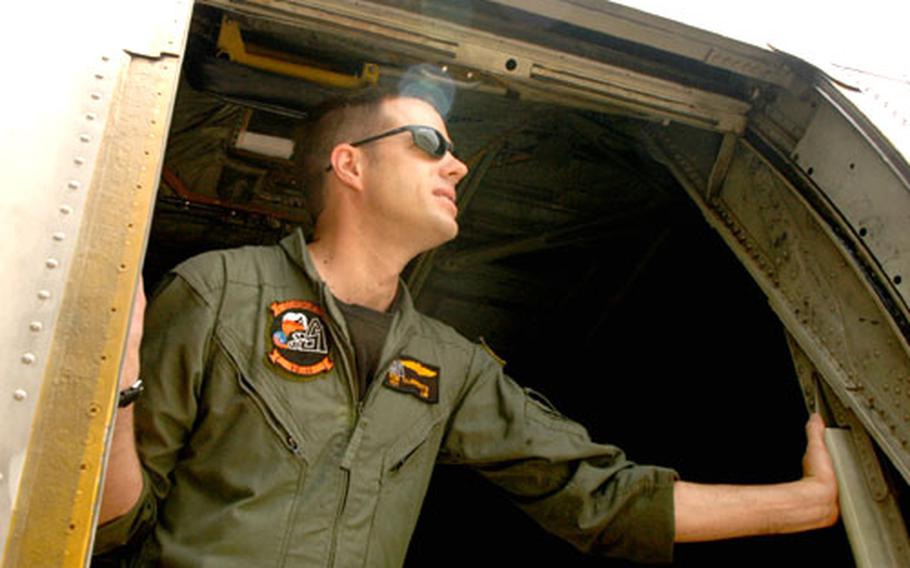
Petty Officer 1st Class Ron Clements, a C-130 loadmaster from VR-64, looks out from his aircraft Tuesday at Atsugi. (Christopher B. Stoltz / Stars and Stripes)
NAVAL AIR FACILITY ATSUGI, Japan — A year ago, the pilots, maintenance personnel and aircrew of the Naval Reserve squadron The Condors, from Willow Grove, Penn., were part of a P-3 squadron. They were practiced in the art of hunting submarines and watching the seas.
That changed Sept. 17, 2004, when the entire squadron converted to a new mission, name and aircraft.
The Condors, previously VP-64 and now VR-64, transformed into an airlift squadron, flying logistics missions in a C-130. The squadron sent its first detachment to Atsugi in late May.
Aircrew members who once manned submarine-detection equipment now balance weight loads; pilots who once flew long-range missions from one single airfield now fly into and out of a variety of airfields on any single mission.
“The P-3 mission was exciting at times and at times it droned along,” said Cmdr. Peter Liston, the squadron executive officer. “A typical P-3 mission starts and stops at the same base.”
During the three-week trip to Atsugi, the detachment moved people and supplies to Australia, Guam, South Korea, all over Japan and several other Pacific islands.
“The C-130 mission is more versatile and ubiquitous,” said Petty Officer 3rd Class Francis Obeya, an aviation structural mechanic. “The P-3 is almost more restrictive.”
Being part of a logistics squadron also can offer immediate gratification: pleased reactions from the people arriving at their destination or receiving their supplies.
In the States, the squadron once carried Marines home after a deployment to Iraq.
“You land and all the families are out there. It’s rewarding,” said Lt. Cmdr. Tom Long, the officer in charge of the detachment to Atsugi and the squadron’s maintenance officer. Now an active-duty reservist and P-3 pilot, he previously flew helicopters, including with HSL-51 at Atsugi.
Petty Officer 1st Class Ron Clements, an aviation ordnanceman, switched from P-3 crewmember to Navy C-130 loadmaster some time ago.
Dropping bombs during training in his old P-3 capacity was exciting, he said, but delivering mail to troops in Iraq — during a detachment to Bahrain with a different C-130 squadron — offers its own very unique rewards. He also now works with different ground crews and with more unusual cargo.
Besides mail, Navy C-130s have carried SEALs, small boats and even trained dolphins.
Many of the squadron’s pilots transitioned from the P-3 to the C-130, which pilots said is somewhat similar to fly. Many also are pilots in their day jobs. Liston is a pilot for Delta Air Lines.
Lt. Cmdr. Trevor Blow, pilot training officer in the squadron, is a furloughed pilot from United Airlines. Commercial flights, he said, are similar to the C-130: made to move people and packages. “It’s one type of logistics to another type,” he said.
For the record ...
Squadron VR-64, The Condors, flies two C-130T Hercules. The T model does many of the same functions as other C-130 models but adds air refueling. The most famous T-model Hercules belongs to the Navy Blue Angels. Named “Fat Albert,” it carries the team’s support and maintenance crew and supplies.
The squadron falls under Commander, Fleet Logistics Support Wing, the Navy’s largest wing, which is the primary operator of logistics aircraft for the Navy. The wing sends detachments to Atsugi, Sigonella, Italy, Bahrain and South America. The wing’s squadrons also fly logistics support throughout the States.
— Juliana Gittler